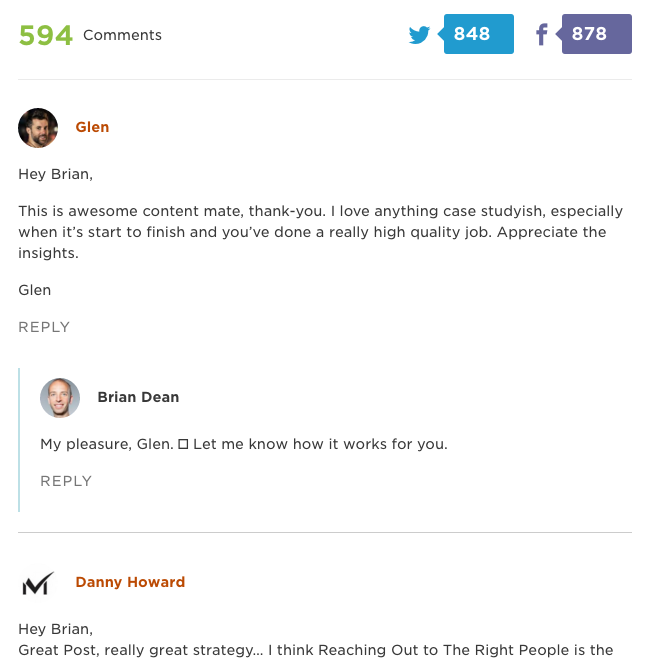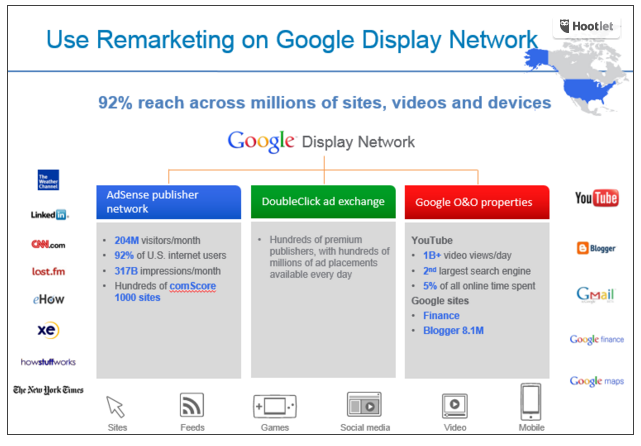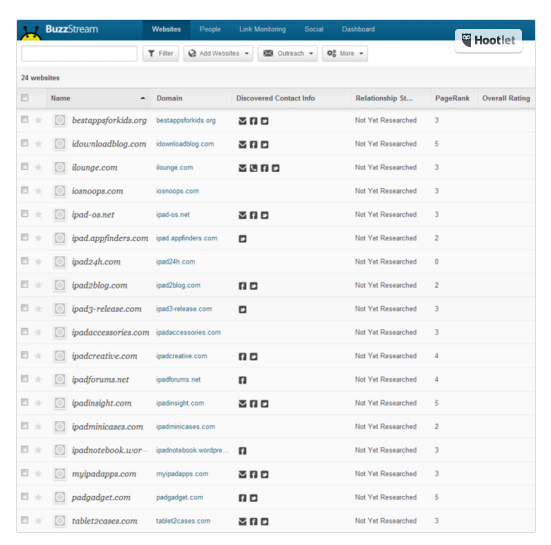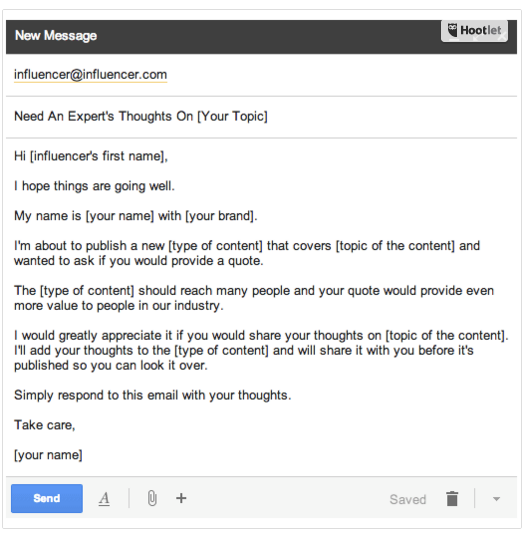
If you’re spending time creating quality content, and not promoting it, you’re losing the content marketing game.
The goal of content marketing is to build an audience. And you can only do that if you get your content into the hands of your consumers. The more people that consume your content, the larger your audience is going to be.
The rule Derek Halpern of Social Triggers uses is to spend 80% of your time promoting content, and only 20% of your time creating it. The reason for this is quite simple: it’s wiser to spend time promoting content you already have, to build your email list, rather than creating more content that fewer people know about. It’s the only way you can truly maximize the ROI on your content.
As they say for products: you can’t just expect that if you ‘build it, they will come’; with content, you can’t just expect that if you ‘create it, they will come’. You’ve got to promote content!
So the golden question is, how do you promote content?
This post will cover 5 ways to promote your content and drive more traffic to your website. So let’s get right into it!
Tactic 1: Commenter & Sharer Outreach
This tactic involves reaching out to commenters and sharers of content similar to the one you’re planning to promote. So if you’ve written a blog post about driverless cars, and someone else has written a post about a similar topic with existing social engagement on it, you can reach out to the people who’ve already commented and shared the other post and let them know about yours. Since they’ve already engaged with a similar post before, it’s clear they have an interest in the topic, so the chances of them engaging with your post are pretty high!
Check out the comments on this blog post. It has more than 594 comments, 848 tweets and 878 comments and shares on Facebook. Most commenters are linked to social media or commenter platforms like Disqus, so it’s possible to reach out to them, and let them know about your post.

Imagine how powerful it can be to have an audience interested in your post, and then asking them to participate. Their comments and feedback can be invaluable and a great way to promote your content. People are more likely to read posts with some social engagement on it, so inviting people already interested in your topic can be an excellent content promotion strategy.
Comment marketing involves getting your name out there as the ‘expert’ in your field. By asking insightful questions and sharing your knowledge as the domain expert, you position yourself as a thought leader in your space, encouraging people to visit your site and consume your content.
Tactic 2: Paid Ads
You always have the option of paying for promoting your content on social media. This includes paid Facebook & Twitter ads, sponsored updates and paid ads on LinkedIn and more. You can boost posts so they appear on the ‘news feed’ of your audience’s social media profiles.
Remarketing can be particularly useful for this purpose, as you can have your ads follow your users once they visit your blog/content. The reason why this is effective is because people need to see your marketing message at least 7 times before they take any specific action on it. This is called the ‘rule of seven’.
Using remarketing, you will be able to reach nearly 84% of your content visitors, for up to 10-18 days a month. That’s extremely powerful when it comes to building a memorable brand. Use the Google display network to your advantage to remain at the front of your customer’s minds. It covers the AdSense publisher network, hundreds of premium publishers and various Google sites as can be seen below:

The thing that differentiates promoted content from advertised services is that promoted content usually solves a problem for a customer. For instance, if someone was looking for ways to decorate their house for Christmas, an eBook about ‘How To Decorate Your House For Christmas’ that’s promoted across the Google Display Network, is probably more effective in generating clicks compared to a Google ad that advertises ‘Interior Decoration Services For Christmas’. People want to know you care, and content is a great way of showing you do!
Tactic 3: Expert Round Up Posts
An expert roundup post is a blog post that includes insights, comments and inputs from experts and involves them in the content creation process. So if you’re writing a post about digital marketing, including insights from the best in the industry like Neil Patel or Avinash Kaushik would be a massive crowd puller.
The reason why this promotional tactic is fantastic is because it helps you build relationships with top influencers. Secondly, involving influencers while writing up your post allows you to leverage their network and drive traffic to your site through them. This can be a real win-win.
Mentioning influencers in your post may also win you a link from their blog or website, and earn you the right to ask the influencers to share your content on their social networks. This can stimulate a massive amount of social engagement, as influencers have large social followings.
Use Followerwonk or BuzzStream to find a list of influencers with large social followings. It’s the quality of their followers and their interest in your content that matters most. Research your influencers social followings, and reach out to them via social or email. Asking them for a quote you can include on your post is an excellent start! BuzzStream usually brings up a list of well known websites & blogs in the specific niche you’re searching for, just like in the image below:

You can use the following email template to reach out to influencers:

Influencer marketing can be a great investment of your time and money. Statistics show that every $1 invested in influencer marketing yields $6.50 in revenue. It’s a channel you just can’t afford to overlook!
Tactic 4: LinkedIn & Facebook Groups
The most intelligent thing you can do with content is: build your community. This not only involves building your email list, it also covers building your social following on social media. By creating a Facebook or LinkedIn group on your topic, you can invite people to join your group, initiate conversations and share your content.
You don’t always need to create your own social group, it’s also possible to share your content in existing online groups, just as long as you don’t try to sell something. The idea is to be part of a social group, just like you would offline! You’ll be welcomed and valued if you truly add value and share your content where necessary.
If you go down the route of creating your own group, getting to 1000 members is a great benchmark before you start evaluating content ROI. Another thing to note is to take an ‘agile’ or ‘lean’ approach to your content. Publish great content, evaluate the results and engagement you drive with it, and then tweak your content creation efforts according to the results you get. This is a great way to invest in the content that performs and eliminate all unnecessary content efforts.
Tactic 5: Reverse Guest Blogging
This tactic involves asking people who are well known authors and get plenty of likes and shares on their content to write for your blog. Inviting popular content creators to write for your blog can be great for promoting existing content on your blog. People start to take notice of your blog when they see well known content creators writing for your blog.
So if you’ve tried guest blogging and it’s not working for you, then simply try the opposite! It’s worth giving it a try and also building your own blog as an important source of information.
Finding great writers to write for your blog can be quite challenging. You can approach all the writers whose content you enjoy reading personally. An effective way of reaching out to great writers is via Twitter. Being an open social network, if you can capture the interest of a writer who interests you, you can build the relationships you need to have regular contributors to your blog.
What’s important in this process is that you actively work out a ‘win-win’ scenario. Asking great writers to write for your blog, without offering them anything in return just wouldn’t work. Think about it from their perspective, and have the mindset of ‘what’s in it for them?’. Only then can you work out something that’s a mutually beneficial strategy!
Wrapping It Up

Like any digital marketing strategy, a good content promotion strategy will take a comprehensive approach across paid, owned and earned media channels. Balancing out content distribution on the right channels at the right time, with strategic PR relationships and paid media can go a long way in maximizing the returns on your content marketing investment.
Frequently Asked Questions about Content Promotion
What is the importance of content promotion in digital marketing?
Content promotion is a critical aspect of digital marketing. It involves distributing blog posts, videos, infographics, and other content types to reach a wider audience. The main goal is to attract, engage, and convert readers into customers. Without content promotion, even the most valuable and high-quality content may not reach its intended audience. It’s like having a great product that no one knows about. Therefore, content promotion helps to increase visibility, drive more traffic to your website, improve brand awareness, and ultimately boost sales and revenue.
How can I effectively promote my content?
Effective content promotion requires a strategic approach. First, identify your target audience and understand their needs, preferences, and content consumption habits. This will guide you in creating relevant and valuable content. Second, leverage multiple channels for content distribution. These may include social media, email newsletters, guest blogging, and paid advertising. Third, optimize your content for search engines to improve its visibility on search engine results pages. Lastly, engage with your audience by responding to their comments and feedback.
What are some common mistakes to avoid in content promotion?
Some common mistakes to avoid in content promotion include not having a clear target audience, failing to optimize content for SEO, relying on a single promotion channel, and not tracking and measuring the results of your content promotion efforts. Avoiding these mistakes can significantly improve the effectiveness of your content promotion strategy.
How can I measure the success of my content promotion efforts?
You can measure the success of your content promotion efforts using various metrics. These may include website traffic, social media shares, comments, likes, and the number of backlinks your content receives. Additionally, you can use tools like Google Analytics to track conversions and determine the return on investment of your content promotion efforts.
Can I use paid advertising for content promotion?
Yes, paid advertising is a powerful tool for content promotion. It can help you reach a larger and more targeted audience. Some popular forms of paid advertising include pay-per-click (PPC) advertising, social media advertising, and sponsored content. However, it’s important to ensure that your paid advertising efforts are cost-effective and deliver a good return on investment.
How can I use social media for content promotion?
Social media is an excellent platform for content promotion. You can share your content on various social media platforms to reach a wider audience. Additionally, you can engage with your audience by responding to their comments and feedback. You can also use social media advertising to reach a more targeted audience.
What is the role of SEO in content promotion?
SEO plays a crucial role in content promotion. By optimizing your content for relevant keywords, you can improve its visibility on search engine results pages. This can drive more organic traffic to your website. Additionally, SEO can help you attract a more targeted audience, which can improve the effectiveness of your content promotion efforts.
Can I use email marketing for content promotion?
Yes, email marketing is a powerful tool for content promotion. You can send newsletters to your subscribers to keep them updated about your latest content. Additionally, you can use email marketing to nurture leads and convert them into customers.
How can I use guest blogging for content promotion?
Guest blogging involves writing articles for other websites in your industry. This can help you reach a larger audience, build backlinks to your website, and establish your authority in your industry. When choosing websites for guest blogging, ensure they have a high domain authority and a relevant audience.
What are some effective content promotion strategies?
Some effective content promotion strategies include SEO, social media marketing, email marketing, guest blogging, and paid advertising. Additionally, engaging with your audience, tracking and measuring your results, and continuously improving your content promotion efforts can significantly enhance their effectiveness.
 Akshay Sachdeva
Akshay SachdevaAkshay is a passionate marketer and enjoys providing innovative and valuable insights to the blog. He is currently the Founder of a Global Content & Growth Marketing Agency, and loves to help startups, agencies and marketing managers grow their business. Interests that excite him include innovation, startups, health & fitness, meaningful experiences, golf & meditation.




